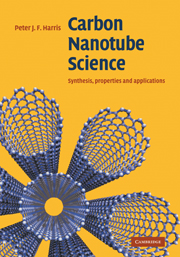Book contents
- Frontmatter
- Contents
- Preface
- 1 Introduction
- 2 Synthesis I: arc- and laser-vaporization, and heat treatment methods
- 3 Synthesis II: catalytic chemical vapour deposition and related methods
- 4 Purification and processing
- 5 Structure
- 6 Physical properties I: electronic
- 7 Physical properties II: mechanical, optical and thermal
- 8 Chemistry and biology of nanotubes
- 9 Carbon nanotube composites
- 10 Filled and heterogeneous nanotubes
- 11 Probes and sensors
- 12 Conclusions
- Name Index
- Subject Index
9 - Carbon nanotube composites
Published online by Cambridge University Press: 20 May 2010
- Frontmatter
- Contents
- Preface
- 1 Introduction
- 2 Synthesis I: arc- and laser-vaporization, and heat treatment methods
- 3 Synthesis II: catalytic chemical vapour deposition and related methods
- 4 Purification and processing
- 5 Structure
- 6 Physical properties I: electronic
- 7 Physical properties II: mechanical, optical and thermal
- 8 Chemistry and biology of nanotubes
- 9 Carbon nanotube composites
- 10 Filled and heterogeneous nanotubes
- 11 Probes and sensors
- 12 Conclusions
- Name Index
- Subject Index
Summary
Many of the outstanding properties of carbon nanotubes that were outlined in Chapters 6 and 7 and elsewhere in this book can be best exploited by incorporating the nanotubes into some form of matrix. The exceptional mechanical properties in particular have prompted huge interest in the production of nanotube-containing composite materials for structural applications. In many cases these composites have employed polymer matrices, but there is also interest in other matrix materials such as ceramics and metals. Preparing such composites is not without its difficulties, however, owing to the tendency of nanotubes to stick together, the challenge of forming bonds between tubes and matrix, and problems associated with the physical properties of some nanotube–matrix mixtures. The aim of this chapter is to give an overview of the very large amount of work that has been carried out on carbon nanotube composites, and to assess how successful this work has been in utilizing the full potential of nanotubes. The incorporation of nanotubes into polymer matrices is considered first.
Preparation of carbon nanotube/polymer composites
Solution mixing
Perhaps the simplest method for preparing nanotube/polymer composites involves mixing nanotube dispersions with solutions of the polymer and then evaporating the solvents in a controlled way. This method has been used with a range of polymers, including polyvinyl alcohol, polystyrene, polycarbonate and poly(methyl methacrylate). In order to facilitate solubilization and mixing, the nanotubes are often functionalized prior to adding to the polymer solution.
- Type
- Chapter
- Information
- Carbon Nanotube ScienceSynthesis, Properties and Applications, pp. 227 - 246Publisher: Cambridge University PressPrint publication year: 2009

